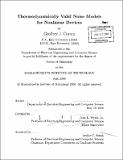| dc.contributor.advisor | John L. Wyatt, Jr. | en_US |
| dc.contributor.author | Coram, Geoffrey J. (Geoffrey John), 1971- | en_US |
| dc.contributor.other | Massachusetts Institute of Technology. Dept. of Electrical Engineering and Computer Science. | en_US |
| dc.date.accessioned | 2006-03-24T18:00:02Z | |
| dc.date.available | 2006-03-24T18:00:02Z | |
| dc.date.copyright | 2000 | en_US |
| dc.date.issued | 2000 | en_US |
| dc.identifier.uri | http://hdl.handle.net/1721.1/29886 | |
| dc.description | Thesis (Ph.D.)--Massachusetts Institute of Technology, Dept. of Electrical Engineering and Computer Science, 2000. | en_US |
| dc.description | Includes bibliographical references (p. 209-221). | en_US |
| dc.description.abstract | Noise has been a concern from the very beginning of signal processing and electrical engineering in general, although it was perhaps of less interest until vacuum-tube amplifiers made it audible just after 1900. Rigorous noise models for linear resistors were developed in 1927 by Nyquist and Johnson [1, 2]. However, the intervening years have not brought similarly well-established models for noise in nonlinear devices. This thesis proposes using thermodynamic principles to determine whether a given nonlinear device noise model is physically valid. These tests are applied to several models. One conclusion is that the standard Gaussian noise models for nonlinear devices predict thermodynamically impossible circuit behavior: these models should be abandoned. But the nonlinear shot-noise model predicts thermodynamically acceptable behavior under a constraint derived here. This thesis shows how the thermodynamic requirements can be reduced to concise mathematical tests, involving no approximations, for the Gaussian and shot-noise models. When the above-mentioned constraint is satisfied, the nonlinear shot-noise model specifies the current noise amplitude at each operating point from knowledge of the device v - i curve alone. This relation between the dissipative behavior and the noise fluctuations is called, naturally enough, a fluctuation-dissipation relation. This thesis further investigates such FDRs, including one for linear resistors in nonlinear circuits that was previously unexplored. The aim of this thesis is to provide thermodynamically solid foundations for noise models. It is hoped that hypothesized noise models developed to match experiment will be validated against the concise mathematical tests of this thesis. Finding a correct noise model will help circuit designers and physicists understand the actual processes causing the noise, and perhaps help them minimize the noise or its effect in the circuit. | en_US |
| dc.description.statementofresponsibility | by Geoffrey J. Coram. | en_US |
| dc.format.extent | 221 p. | en_US |
| dc.format.extent | 9388088 bytes | |
| dc.format.extent | 9416671 bytes | |
| dc.format.mimetype | application/pdf | |
| dc.format.mimetype | application/pdf | |
| dc.language.iso | eng | en_US |
| dc.publisher | Massachusetts Institute of Technology | en_US |
| dc.rights | M.I.T. theses are protected by copyright. They may be viewed from this source for any purpose, but reproduction or distribution in any format is prohibited without written permission. See provided URL for inquiries about permission. | en_US |
| dc.rights.uri | http://dspace.mit.edu/handle/1721.1/7582 | |
| dc.subject | Electrical Engineering and Computer Science. | en_US |
| dc.title | Thermodynamically valid noise models for nonlinear devices | en_US |
| dc.type | Thesis | en_US |
| dc.description.degree | Ph.D. | en_US |
| dc.contributor.department | Massachusetts Institute of Technology. Department of Electrical Engineering and Computer Science | |
| dc.identifier.oclc | 46804504 | en_US |
